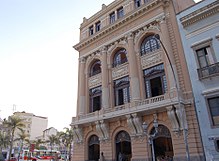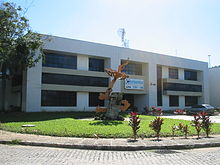Education in Brazil
[5] When Portuguese explorers arrived in Brazil in the 16th century and started to colonize their new possessions in the New World, the territory was inhabited by indigenous peoples and tribes who had no writing system or school education.
However, the society's engagement in trade, architecture, science, literature, languages, arts, music and religious debate corresponded to the same main purpose of Christianisation.
By the middle of the 16th century the Jesuits were present in West Africa, South America, Ethiopia, India, China, and Japan.
Throughout the centuries of Portuguese rule, Brazilian students, mostly graduated of the Jesuit missions and seminaries, were allowed to enroll at higher education in mainland Portugal.
The Jesuits, a religious order founded to promote the cause and teachings of Catholicism, had gained influence with the Portuguese crown and over education, and had begun missionary work in Portugal's overseas possessions, including the colony of Brazil.
By 1700, and reflecting a larger transformation of the Portuguese Empire, the Jesuits had decisively shifted from the East Indies to Brazil.
In the late 18th century, Portuguese minister of the kingdom, the Marquis of Pombal, attacked the power of the privileged nobility and the church, and expelled the Jesuits from Portugal and its overseas possessions.
Following the expulsion of Jesuits from Brazil, education was primarily left to remaining religious organizations and military institutions, which developed to protect Portuguese interests in the area following the discovery of gold.
[6] In 1772, before the establishment of the Science Academy of Lisbon (1779), one of the first learned societies of Brazil and the Portuguese Empire was founded in Rio de Janeiro: the Sociedade Scientifica.
During the late 18th century, the Escola Politécnica (Polytechnic School) was created, then the Real Academia de Artilharia, Fortificação e Desenho (Royal Academy for Artillery, Fortifications and Design) was created in Rio de Janeiro, 1792, through a decree issued by the Portuguese authorities as a higher education school for the teaching of the sciences and engineering.
In the 19th century, the Portuguese royal family, headed by then prince regent John, arrived in Rio de Janeiro, escaping from the Napoleonic invasion of Portugal in 1807.
According to the national census made in that year, among the free inhabitants (8,419,672 people), 38% were white, 39% were mixed race and 11% were black.
[6] Additionally, preparatory exams for secondary and tertiary education began to be widely used during the First Republic era.
[6] Education during this period continued to be mostly inaccessible to the black population of Brazil, due to the variety of socio-economic pressures they faced despite the abolition of slavery.
[9] The problems of primary and secondary education were compounded by significant quality differences across regions, with the northeast suffering dramatically.
"Citizen schools" emerged, designed to promote critical thinking, incorporation of marginalized people, and curiosity (over rote memorization and obedience).
[18] Led by educators like Paulo Freire, the campaigns hoped to combat the high amounts of illiteracy in the countryside.
[18] Paulo Freire's methods were widely popular due to the immediacy in which they seemed to work: as he claimed, a student could learn to read and write in 40 hours.
[18] The growing fear of communism and the rising power of the military led to the end of the campaigns in 1964 and the exile of Freire and others like him.
[21] Brazil has also implemented the IDEP, the Index of Basic Education Development, which evaluates school flow and performance rates in the test.
[22] IDEP also led to the creation of the Social Mobilisation program which works to involve the entire community in the educational system.
[24] It takes an extra three years to finish elementary school for low-income students, PNAD, the national household survey, shows.
[25] Rio de Janeiro began a program in 2009 called the Reforço Escolar testing all students in the beginning of the school year to discover all who are not yet at grade level.
[26] Additionally, many rural and indigenous regions have particularly low access to technology and reliable internet, making virtual learning widely inaccessible to students from those areas.
While the differences between them have narrowed in the 21st century, black students on average get about one year of education less than their white counterparts.
Older students who have not completed their elementary education are allowed to attend, though those over 18 are separated from the younger children.
The number of candidates per available place in the freshman class may be in excess of 30 or 40 to one in the not so competitive courses at the top public universities.
The Brazilian standard for technology (Associate degree), licentiate or bachelor's degree is awarded in most areas of the arts, humanities, social sciences, exact sciences, or natural sciences, and lasts two to three years for technology courses, three to four years for licenciate and bachelor's courses in general and five to six years for special bachelor's courses such as law, architecture, engineering, human medicine and veterinary medicine.
Lato sensu graduate degrees are specializations and refinements lasting one to two years and do not confer academic title.
[40] Studies show that, despite the expansion of access to Higher Education in Brazil, this had very limited impact on the country's social disparities.








